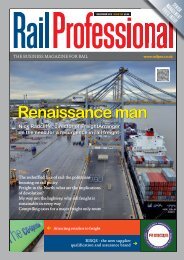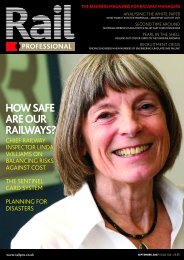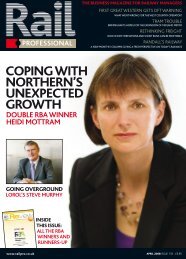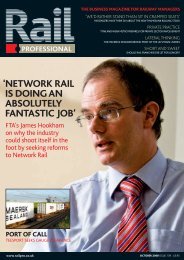move over freightliner, we want to get into ... - Rail Professional
move over freightliner, we want to get into ... - Rail Professional
move over freightliner, we want to get into ... - Rail Professional
You also want an ePaper? Increase the reach of your titles
YUMPU automatically turns print PDFs into web optimized ePapers that Google loves.
INFRASTRUCTURE<br />
At 8.1 metres in diameter, the tunnels beneath London that<br />
High Speed 1 will be using are the largest ever under a UK city.<br />
waving razzmatazz. The second phase, which<br />
includes 11.5 miles of tunnelling under the<br />
approaches <strong>to</strong> London, was always seen as<br />
carrying more risk.<br />
‘Obviously, coming in<strong>to</strong> south-east London<br />
there are hundreds of thousands of homes that<br />
potentially could have been affected,’ explains<br />
Bennett. ‘But the construction of the tunnels<br />
<strong>we</strong>nt exceptionally <strong>we</strong>ll with very little<br />
disruption.’<br />
Not that everything <strong>we</strong>nt entirely <strong>to</strong> plan.<br />
Bennett recalls one <strong>we</strong>ll-publicised incident at<br />
Stratford when a tunnelling machine hit an<br />
uncharted <strong>we</strong>ll. ‘Sometime after the tunnelling<br />
machine passed through, part of a back garden<br />
disappeared. It was behind a row of very pleasant<br />
but fairly modest terraced houses. But it was<br />
reported that the insurance claim included a<br />
Harley Davidson and several crates of<br />
Champagne that had disappeared down the<br />
hole!’<br />
That’s the sort of thing that can happen when<br />
you are digging nearly 12 miles of tunnels, which<br />
also leaves you with a mountain of spoil <strong>to</strong><br />
dispose of. ‘Potentially <strong>we</strong> <strong>we</strong>re looking at<br />
Tunnel vision<br />
Constructing a railway line in nearly 12 miles of<br />
tunnels isn’t easy – particularly when the track<br />
has <strong>to</strong> be fixed on<strong>to</strong> concrete slab.<br />
‘You are limited <strong>to</strong> how you can <strong>get</strong> the<br />
materials in,’ says Dave Bennett, highlighting<br />
one of the main difficulties.‘There’s the tunnel<br />
entrance and a small number of major shafts –<br />
and that’s it!’<br />
Undeterred, contrac<strong>to</strong>rs working on the highprofile<br />
project came up with an innovative<br />
hundreds of thousands of lorry loads of material<br />
that would have had <strong>to</strong> have been transported<br />
through London, with a hefty bill <strong>to</strong> be paid for<br />
disposing of it all,’ says Bennett.<br />
The development site at Stratford, which will<br />
be home <strong>to</strong> the 2012 London Olympics, came<br />
<strong>to</strong> the rescue, as Bennett explains: ‘It is a lowlying<br />
area prone <strong>to</strong> flooding. So <strong>we</strong> used almost<br />
all of the tunnelling material <strong>to</strong> raise the entire<br />
40-hectare sight by up by eight metres. It had the<br />
dual benefit of making the land significantly<br />
more developable and cutting out the need for<br />
solution. Rather than take the concrete in<strong>to</strong> the<br />
tunnels, they decided <strong>to</strong> make it on a specially<br />
adapted train.<br />
Bennett elaborates:‘In practice <strong>we</strong> created a<br />
complete concrete fac<strong>to</strong>ry on a train that was<br />
several hundred metres long.<br />
‘The raw materials <strong>we</strong>re carried on the train<br />
and the concrete mix was pumped out of a pipe<br />
at the front <strong>to</strong> exactly where it was needed in<br />
the tunnel.’<br />
all those environmentally damaging lorry<br />
journeys. It’s a very good example of how High<br />
Speed 1 has worked <strong>to</strong> minimise its impact on<br />
the environment.’<br />
With attention switching inevitably <strong>to</strong><br />
November’s grand opening, all eyes are now on<br />
St Pancras and the new International station<br />
taking shape behind the familiar Vic<strong>to</strong>rian<br />
edifice on London’s busy Eus<strong>to</strong>n road. Bennett<br />
says: ‘People talk about the station in the same<br />
way as they would St Paul’s cathedral. And <strong>we</strong><br />
have the job of putting four railways in<strong>to</strong> it: high<br />
MAY 2007 : RAIL PROFESSIONAL<br />
25

















